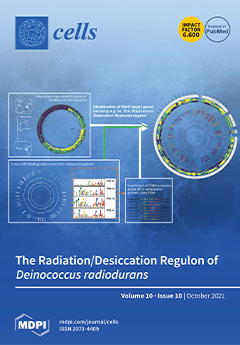Amyotrophic lateral sclerosis (ALS) is a progressive nervous system disease that causes motor neuron (MN) degeneration and results in patient death within a few years. To recapitulate the cytopathies of ALS patients’ MNs,
SOD1G85R mutant and corrected
SOD1G85G isogenic-induced pluripotent stem
[...] Read more.
Amyotrophic lateral sclerosis (ALS) is a progressive nervous system disease that causes motor neuron (MN) degeneration and results in patient death within a few years. To recapitulate the cytopathies of ALS patients’ MNs,
SOD1G85R mutant and corrected
SOD1G85G isogenic-induced pluripotent stem cell (iPSC) lines were established. Two
SOD1 mutant ALS (
SOD1G85R and
SOD1D90A), two
SOD1 mutant corrected (
SOD1G85G and
SOD1D90D), and one sporadic ALS iPSC lines were directed toward MNs. After receiving ~90% purity for MNs, we first demonstrated that
SOD1G85R mutant ALS MNs recapitulated ALS-specific nerve fiber aggregates, similar to
SOD1D90A ALS MNs in a previous study. Moreover, we found that both
SOD1 mutant MNs showed ALS-specific neurite degenerations and neurotransmitter-induced calcium hyperresponsiveness. In a small compound test using these MNs, we demonstrated that gastrodin, a major ingredient of
Gastrodia elata, showed therapeutic effects that decreased nerve fiber cytopathies and reverse neurotransmitter-induced hyperresponsiveness. The therapeutic effects of gastrodin applied not only to
SOD1 ALS MNs but also to sporadic ALS MNs and
SOD1G93A ALS mice. Moreover, we found that coactivation of the GSK3β and IGF-1 pathways was a mechanism involved in the therapeutic effects of gastrodin. Thus, the coordination of compounds that activate these two mechanisms could reduce nerve fiber cytopathies in
SOD1 ALS MNs. Interestingly, the therapeutic role of GSK3β activation on
SOD1 ALS MNs in the present study was in contrast to the role previously reported in research using cell line- or transgenic animal-based models. In conclusion, we identified in vitro ALS-specific nerve fiber and neurofunctional markers in MNs, which will be useful for drug screening, and we used an iPSC-based model to reveal novel therapeutic mechanisms (including GSK3β and IGF-1 activation) that may serve as potential targets for ALS therapy.
Full article






